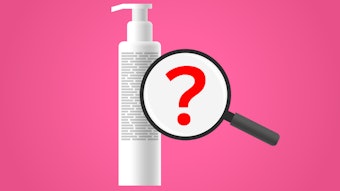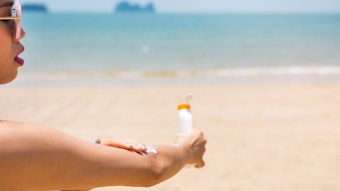
To read this article in its entirety, click through to your April 2020 digital magazine. . .
Sunscreens have improved immensely in the past 40 years thanks to advances in formulation and a deeper understanding of sunlight and exposure. As a natural extension of progress, however, new pain points have emerged; these are discussed in brief in this commentary from world-renowned sunscreen expert Brian Diffey, Ph.D., of Newcastle University. Continue reading on Page DM1 of the April digital magazine.
Exposure Myths
Misunderstandings about environmental sun exposure are common in the dermatological and cosmetic literature. It is a fact1 that both UVA and erythemal UV (largely UVB) vary over the course of a clear day in an approximate bell-shaped fashion beginning at sunrise, reaching a peak around noon and ending at sunset. Yet it is not uncommon to read in the literature phrases such as: UVB intensity declines from noontime apex, but UVA intensity remains relatively constant throughout the day.2
Likewise, measurements show unequivocally that UVA and UVB both show a daily variation throughout the year that peaks in the summer months and reaches a minimum in mid-winter, with a summer to winter variation that becomes more marked as we move further from the equator. For example, in New York (latitude 40.8°N), the mid-winter and mid-summer UV indices on a clear day are 2 and 10, respectively, while the corresponding UVA ambient levels over a winter and summer day are about 40 J/cm2 and 170 J/cm2, respectively. Nevertheless, we find statements such as: It is useful to remember that the level of UVA reaching the earth’s surface is very similar in both summer and winter.3
Both of these examples from the dermatological literature are clearly wrong, and misinformation such as this may have contributed to the promotion of the need for year-round sun protection even at northerly latitudes.
For example, the American Academy of Dermatology (AAD) recommends that everyone should apply SPF 30 (or higher) sunscreen every day before going outdoors.4 Yet estimates for northern Europe5 indicate that during day-to-day outdoor exposure, we get less than the equivalent of 1 MED (minimal erythema dose) in skin type II on about 360 days per year, a daily exposure of less than 0.1 MED for about six months of the year, and less than 0.01 MED on about 30 days per year.
So is this advice really necessary for people living in the northern regions of Europe (e.g., UK) and North America, given that some exposure to sunshine is essential for the healthy maintenance of our vitamin D levels? Obviously, it is a different scenario during recreational exposure, when we may be in strong sunshine for several hours and exposure is much higher—sunscreens are strongly recommended as part of the sun protection toolbox.
The AAD’s advice is more appropriate advice people living in regions approaching the tropics, since similar calculations for Florida indicate a daily exposure of more than 0.1 MED on about 300 days per year.
IR-A Protection Claims
Laboratory studies over the past decade or so have shown that infrared exposure can induce a number of adverse effects both in cellular models and in human skin,6 and these results have been taken to infer that the infrared-A (IR-A) part of the sun’s spectrum may contribute to premature skin aging, necessitating the need for agents incorporated into sunscreens that can mitigate these effects. As a consequence, we now have an abundance of sunscreen products claiming to provide not only protection against UV, but also IR-A.
What is not often appreciated, however, is that the intensities of IR-A radiation used in laboratory studies typically exceed greatly what we are exposed to in sunlight. For example, someone lying under an open cloudless sky is only exposed to about one-tenth of the typical IR-A intensity used in laboratory studies,7 and for someone walking around under an open sky, the IR-A intensity on vertical body surfaces falls to about one-fiftieth of the typical laboratory value.
These large differences in IR-A intensity are important because the thermal effect of an exposure at incident irradiances expected in summer sunlight differs drastically from the heating of skin when using irradiances typical of laboratory studies. Because of the large differences in irradiance, we have to question how relevant the findings from laboratory studies are in the context of normal behavior and exposure in the sun, especially since, IR-A may be more beneficial than harmful when we are exposed to irradiances and doses commensurate with those in real life.8
. . .Read more in our April 2020 digital edition. . .
References
- Diffey, B.L. (2017). Sun Protection: A Risk Management Approach. Bristol: IOP Publishing, Bristol, p 3-18.
- Lowe, N.J. and Friedlander, J. (1995). Prevention of photodamage with sun protection and sunscreens. In: Gilchrest, B.A., ed, Photodamage. Cambridge, MA: Blackwell Science Inc., p 202.
- Marks, R. (1992). Sun-damaged Skin. London: Martin Dunitz Ltd., p 62.
- American Academy of Dermatology (AAD) website. (Accessed 2020, Feb 17). 10 Skin care secrets for healthier-looking skin. Retrieved from https://www.aad.org/skin-care-secrets/healthier-looking-skin.
- Diffey, B.L. (2008). A behavioral model for estimating personal exposure to solar ultraviolet radiation. Photochem Photobiol 84 371–375.
- Grether-Beck, S., Marini, A., Jaenicke, T. and Krutmann, J. (2014). Photoprotection of human skin beyond ultraviolet radiation. Photodermatol Photoimmunol Photomed 30 167-174.
- Diffey, B. and Cadars, B. (2016). An appraisal of the need for infrared radiation protection in sunscreens. Photochem Photobiol Sci 15 361-364.
- Barolet, D., Christiaens, F. and Hamblin, M.R. (2016). Infrared and skin: Friend or foe. J Photochem Photobiol B: Biology 155 78-85.











